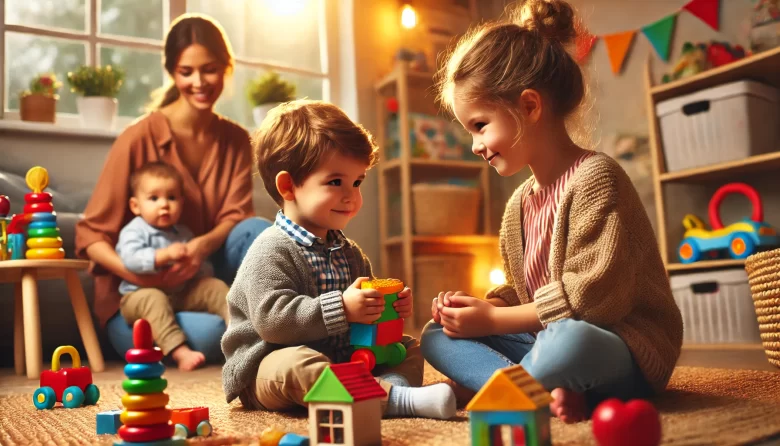Empathy and respect are fundamental values that shape a child’s ability to form healthy relationships, resolve conflicts, and understand the emotions of others. Teaching these values from an early age helps children grow into compassionate, considerate, and emotionally intelligent individuals.
In this article, we’ll explore the importance of empathy and respect, along with engaging activities to help children develop these essential social skills.
Why Are Empathy and Respect Important for Children?
Teaching empathy and respect helps children:
- Develop strong friendships – Understanding and caring about others’ feelings improves social interactions.
- Handle conflicts better – Children learn to consider different perspectives and resolve disagreements peacefully.
- Build emotional intelligence – Recognizing emotions in themselves and others leads to better self-regulation.
- Foster kindness and inclusivity – Respect for diversity helps children appreciate differences and be more accepting of others.
By incorporating empathy-building activities into daily routines, parents and educators can create a nurturing environment that promotes kindness and understanding.
How to Teach Empathy and Respect to Children
Model Empathy and Respect in Everyday Life
Children learn by observing adults. Demonstrate respectful and empathetic behavior by:
- Listening attentively when they express their feelings.
- Using kind words and showing appreciation.
- Treating others with respect, including family members, neighbors, and service workers.
By modeling these behaviors, you set a powerful example for your child to follow.
Encourage Perspective-Taking
Help children understand different viewpoints by asking questions like:
- “How do you think your friend felt when you shared your toy?”
- “What would you do if someone was sad and needed comfort?”
This practice encourages them to step into someone else’s shoes and consider how their actions affect others.
Read Books That Teach Empathy and Respect
Storytelling is a great way to introduce moral lessons in a relatable way. Choose books that feature characters showing kindness, helping others, or learning from mistakes. Some excellent books for teaching empathy include:
- The Rabbit Listened by Cori Doerrfeld
- Have You Filled a Bucket Today? by Carol McCloud
- A Sick Day for Amos McGee by Philip C. Stead
After reading, ask questions like:
- “How did the character feel?”
- “What would you do in their situation?”
Discussing the emotions and actions of story characters helps children process real-life situations with more empathy.
Encourage Acts of Kindness
Simple gestures can help children develop empathy naturally. Encourage:
- Sharing toys with friends or siblings.
- Making thank-you cards for teachers or family members.
- Helping a younger sibling or friend with a task.
You can also create a “Kindness Jar” where children add notes about kind actions they’ve done or witnessed. This reinforces positive behavior.
Practice Active Listening
Teach children to listen attentively by making eye contact and responding thoughtfully. You can practice this by playing games like:
- Echo Game – Have your child repeat what you say to reinforce listening skills.
- Story Swap – Take turns telling short stories and summarizing what the other person said.
These activities help children learn that listening is just as important as speaking.
Fun Activities to Teach Empathy and Respect
Role-Playing Scenarios
Create real-life situations where children can practice empathy. Some examples include:
- Being a Friend in Need – One child pretends to be sad, and the other offers comfort.
- Helping a Lost Toy – Act out a scene where a toy is lost, and the child must help find its owner.
- Taking Turns – Role-play scenarios where sharing and patience are required.
This activity helps children understand the importance of kindness in different situations.
Emotion Charades
Write different emotions on cards (happy, sad, frustrated, excited, etc.), and have children act them out while others guess. This helps kids recognize and understand emotions in others.
The “I Feel, I See” Game
Encourage children to describe emotions using both words and observations:
- “I feel happy when I play with my best friend.”
- “I see that my friend is sad because he dropped his ice cream.”
This activity reinforces emotional awareness and helps children connect feelings with actions.
Creating a “Respect Tree”
Draw a large tree on a poster board and add “leaves” made of paper. Each time a child shows respect (listening, saying thank you, helping someone), they add a leaf with a description of their action.
Seeing the tree grow encourages children to continue respectful behaviors.
Volunteering Together
Helping others in the community teaches children about generosity and compassion. Ideas include:
- Donating clothes or toys to charity.
- Writing kind notes for elderly neighbors.
- Participating in a local clean-up event.
Volunteering allows children to experience the joy of giving and understand the impact of their actions.
Gratitude Circle
At the end of each day, sit in a circle and take turns saying something they are grateful for. Expressing gratitude helps children recognize kindness in their lives and fosters appreciation for others.
How to Reinforce Empathy and Respect Daily
Praise Empathetic Behavior
When your child shows kindness, acknowledge it:
- “That was very kind of you to share your crayons with your friend!”
- “I love how you helped your little sister pick up her toys.”
Recognizing and reinforcing these actions encourages children to repeat them.
Set Clear Expectations
Teach children the importance of polite behavior by emphasizing:
- Saying “please” and “thank you.”
- Waiting their turn to speak.
- Respecting different opinions, even if they disagree.
Reflect on Conflicts Together
When disagreements happen, guide your child through resolving them by asking:
- “How do you think the other person felt?”
- “What could we do differently next time?”
Helping children reflect on conflicts fosters better decision-making in the future.
When to Seek Additional Support
While empathy and respect develop naturally over time, some children may struggle with social interactions. If your child:
- Frequently has difficulty understanding others’ feelings.
- Shows aggressive or disrespectful behavior often.
- Struggles to form friendships.
Consider consulting a child psychologist or counselor to provide additional guidance.
Final Thoughts
Teaching empathy and respect from an early age helps children develop into compassionate, emotionally intelligent individuals. Through role-playing, storytelling, and acts of kindness, parents and caregivers can create meaningful learning experiences that reinforce these values.
By consistently modeling respect, encouraging open conversations, and engaging in empathy-building activities, you can help your child navigate the world with kindness, understanding, and strong social skills.
Empathy and respect aren’t just lessons—they’re lifelong values that shape the way children connect with the world around them.




